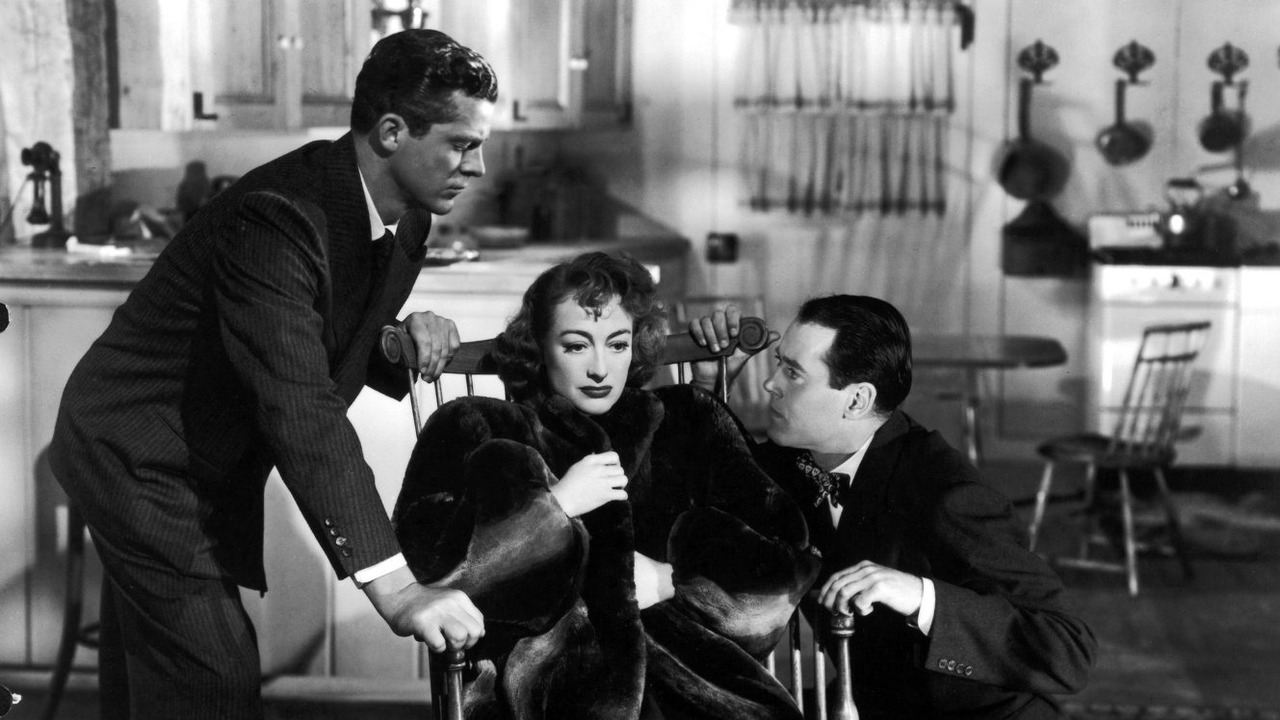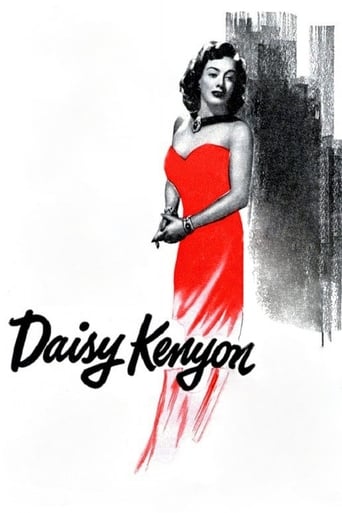

A well off and capable New York corporate lawyer (Dana Andrews) carries on an ongoing affair with a successful fashion designer (Joan Crawford) who waits for him to divorce his wife (Ruth Warrick). This he finds difficult to do because of the two daughters and his position with his father-in-law whose law firm he works for. There are some complex issues in this situation with the wife, kids, work, and Joan Crawford in a fairly tender part as Daisy. The dialogue between the characters shows a sophistication as they deal with the situation that is fairly impressive. When Henry Fonda shows up as a widowed WW2 vet, there are several scenes between him and Andrews or with him, Andrews, and Crawford that move right along with interesting observations, as both men love the same woman, and the woman, who loves them both, seems to want to keep her own identity as well. The divorce court scenes come in towards the end to make the film a court drama as well, but do not intrude as the issues with Crawford's character become exposed by the lawyer representing the Andrew's wife. Though the film is not a crime drama, a lot of the B&W photography by Leon Shamroy looks like ace film noir. Some may say that director Otto Preminger would not voluntarily take on a project like this, that it must have been contractually foisted upon him. If so, he did a fairly admirable job, keeping the characters from going over the top while keeping up the pace and making a pretty tough ending with a surprisingly tender Dana Andrews, whose definitely at or near his best.
... View MoreThis is a well-crafted "love triangle" movie in the visual style of film noir, but without the plot development typical of film noir. No murders, gangsters, or cops. The cinematography is excellent and Preminger shows his mastery as a director, eliciting stellar performances from Joan Crawford, Dana Andrews, and Henry Fonda.Crawford in particular shows her star quality with superbly nuanced articulation and facial expressions. Her opening lines are amazing to listen to, her voice quavering nervously to show that she is under tremendous emotional pressure.Dana Andrews gives probably the best performance of his career as the cheating husband who really wants to make things work, but is torn between his neurotic wife, his adorable kids, and his mistress.Henry Fonda gives a brilliantly understated characterization of an eccentric war-torn hero hiding behind a veneer of gentleness and innocence, who cleverly but compassionately manipulates the situation in order to bring about a satisfactory resolution.There a few plot twists and a happy ending. Highly recommended.
... View MoreJoan Crawford is "Daisy Kenyon" in this 1947 film about a woman torn between two men - one, a married, successful man (Dana Andrews), and the other, a returning soldier and widower (Henry Fonda). Directed by Otto Preminger, it's a good noir, better than "Dark Angel" but nowhere near "Laura." Andrews is married to Ruth Warrick and has two daughters who need him, as their mother, when unhappy, tends to be abusive. He has a long-time relationship with Daisy, who is a successful commercial artist. The situation isn't ideal for her, but she's in love. One night she meets a soldier who wants to build a life with her. Can she break from Andrews - and will he let her? There are several striking things about this film. One is the casting. In order to play the lead in "Grapes of Wrath" in 1940, Darryl Zanuck forced Henry Fonda to sign a 7-year-contract, for which Fonda never forgave him. One can see an example of why here. In this film, he has to share leading man duties with Dana Andrews in what is, in fact, a Joan Crawford movie. To me, Fonda's role in this seems very inauspicious and one where a lesser star could have been cast. Just an opinion. He's excellent as a lonely, unhappy man who falls for Daisy - Fonda at this point still had some traces of boyishness.The second striking thing for me was the subtlety of the acting. There is a scene in which Dana Andrews, returning from an 18-day-trip, can't get the usually reliable Daisy on the phone, so he goes to see her. It's a scene that should be shown in acting schools - full of atmosphere and subtext, so little is said in dialogue; so much is what lies beneath the surface. Both Crawford and Andrews give wonderful performances.The third striking thing is the Greenwich Theater, which I had no idea was torn down until now. There was indeed a restaurant across from it, too. That's also my old neighborhood, and it was a delight to see. I believe I went to the opening day of "Fargo" there.Throughout the film, the symbolism of a New York cab is used: if you were staying where you were, you let the cab go; if not, you asked it to wait. The theme reinforces the ending of "Daisy Kenyon" very well. A good movie.
... View MoreSome movies age well, some don't. This movie has not aged well. Joan Crawford's acting is stagy, the story contrived, the story's mood gloomy and the film-noir style bleak and stark. Ms. Crawford was too old for the role. Daisy Kenyon is a young career woman, not a middle aged lady set in her ways. Also, the movie features two leading men, Dana Andrews and Henry Fonda which further weakens the story as Ms. Kenyon goes from one man, to the other, sometimes to both, then back to the other, etc. Real Hollywood pulp lacking substance, utterly vacuous, and above all dated. The movie is slow-paced and obviously filmed in a studio. Maybe this movie was popular in 1947 but in 2008 it's just another Hollywood curio that belongs on the shelf.
... View More